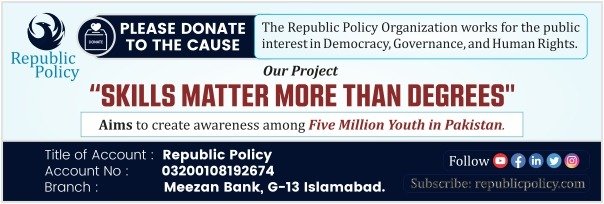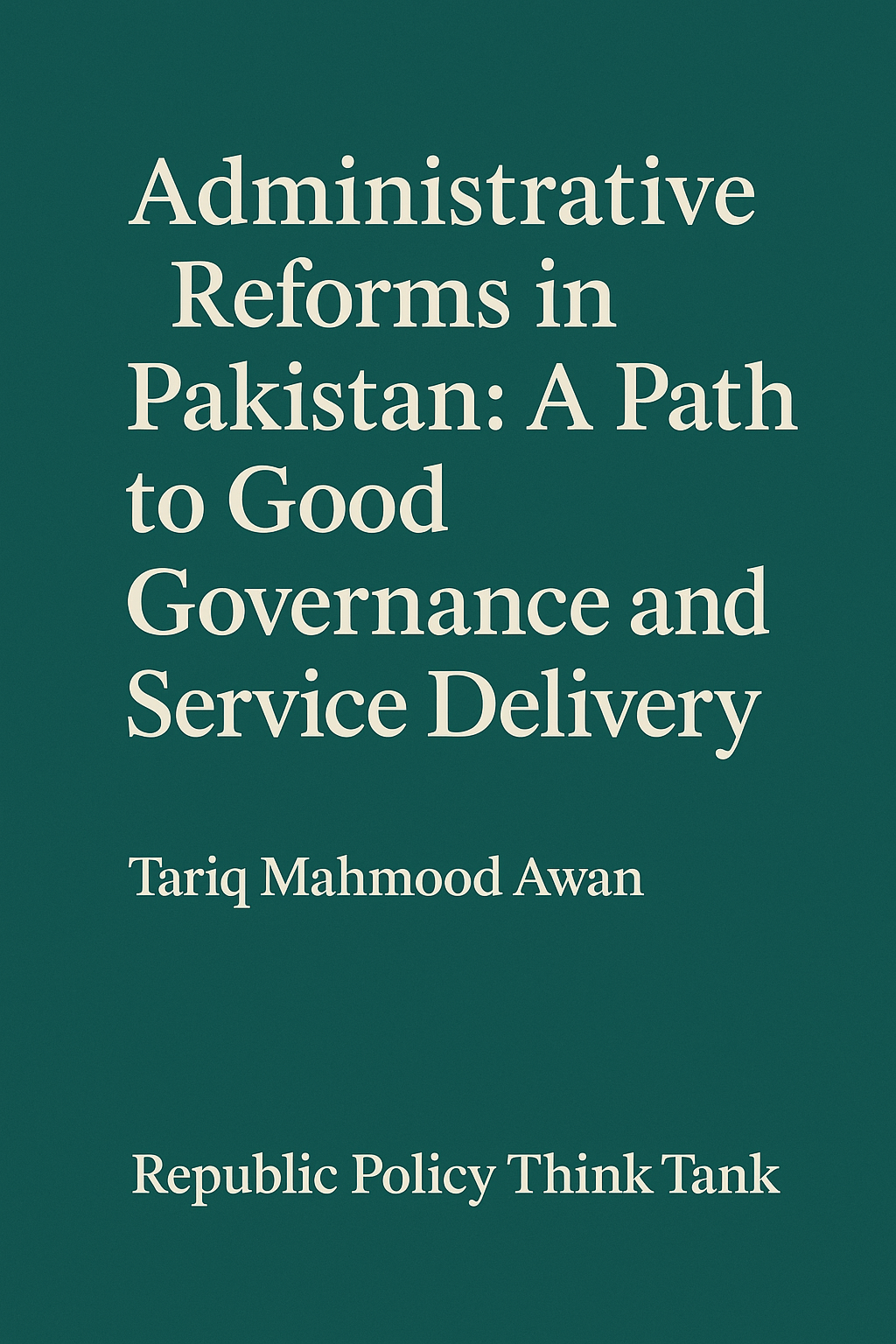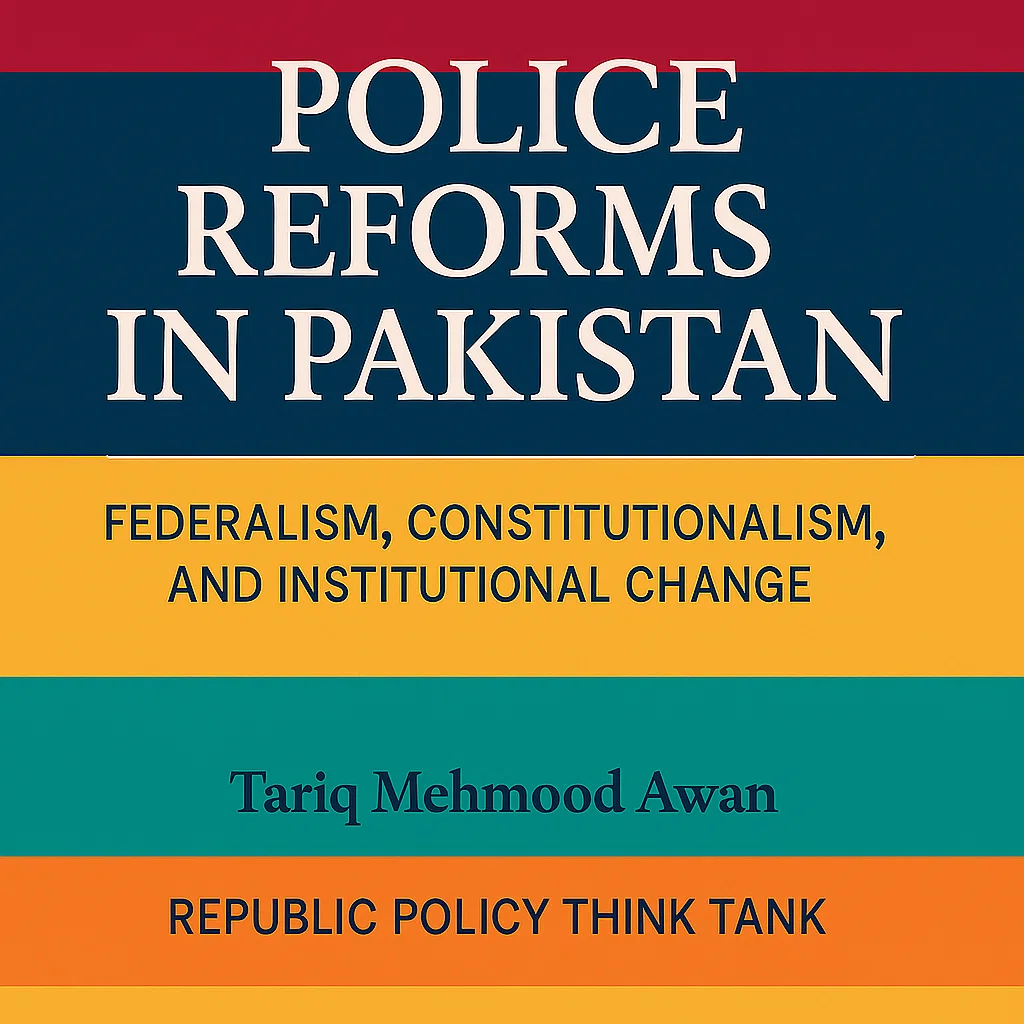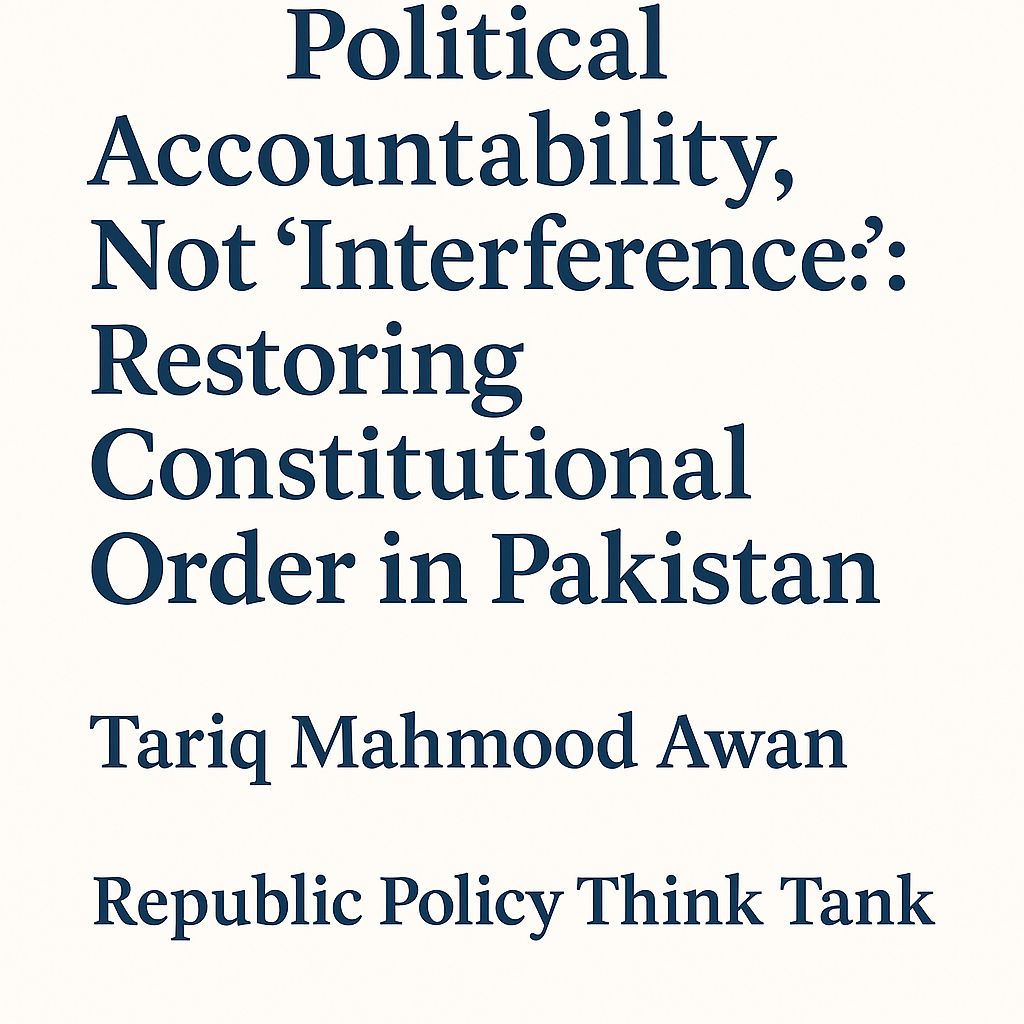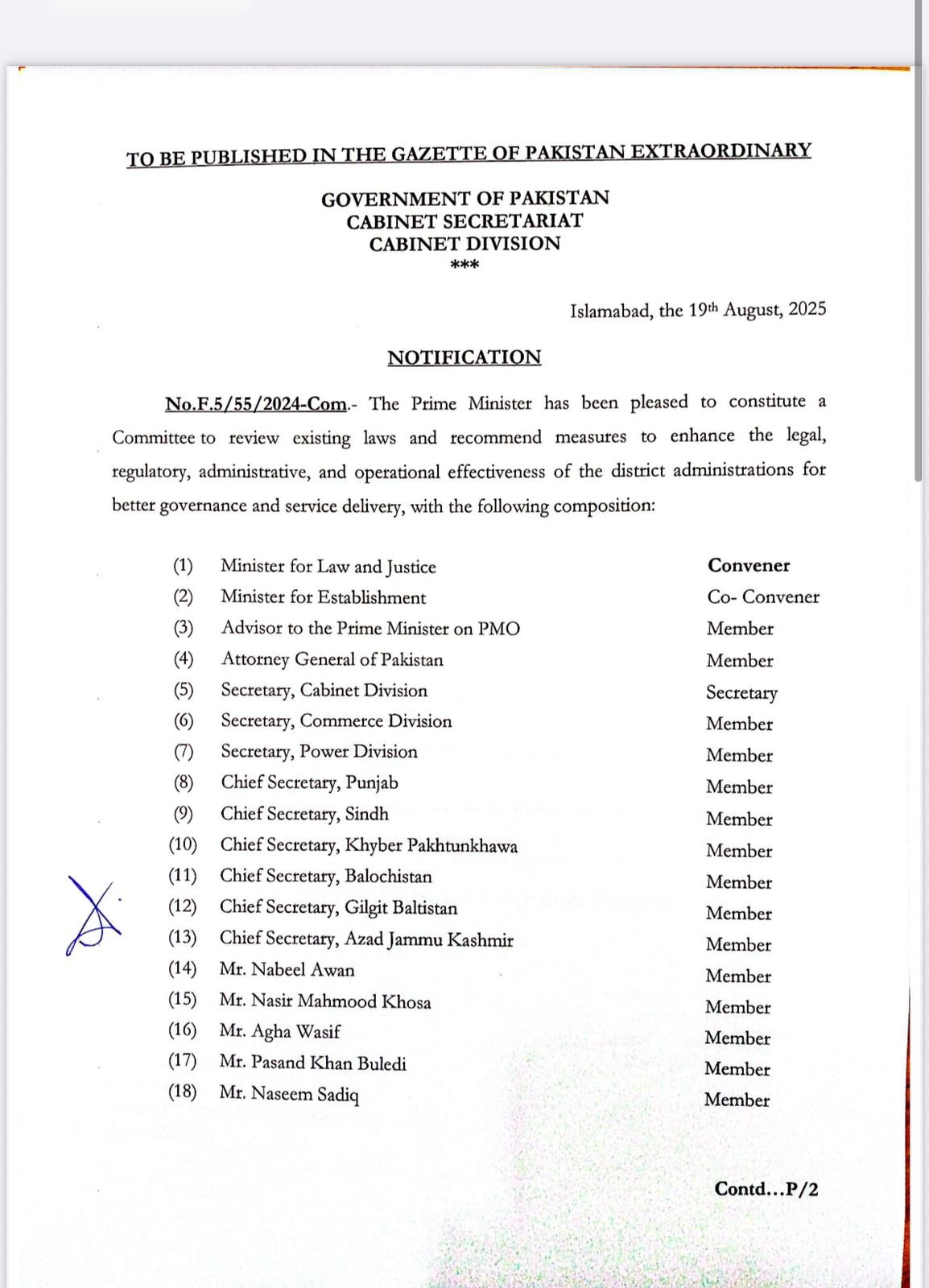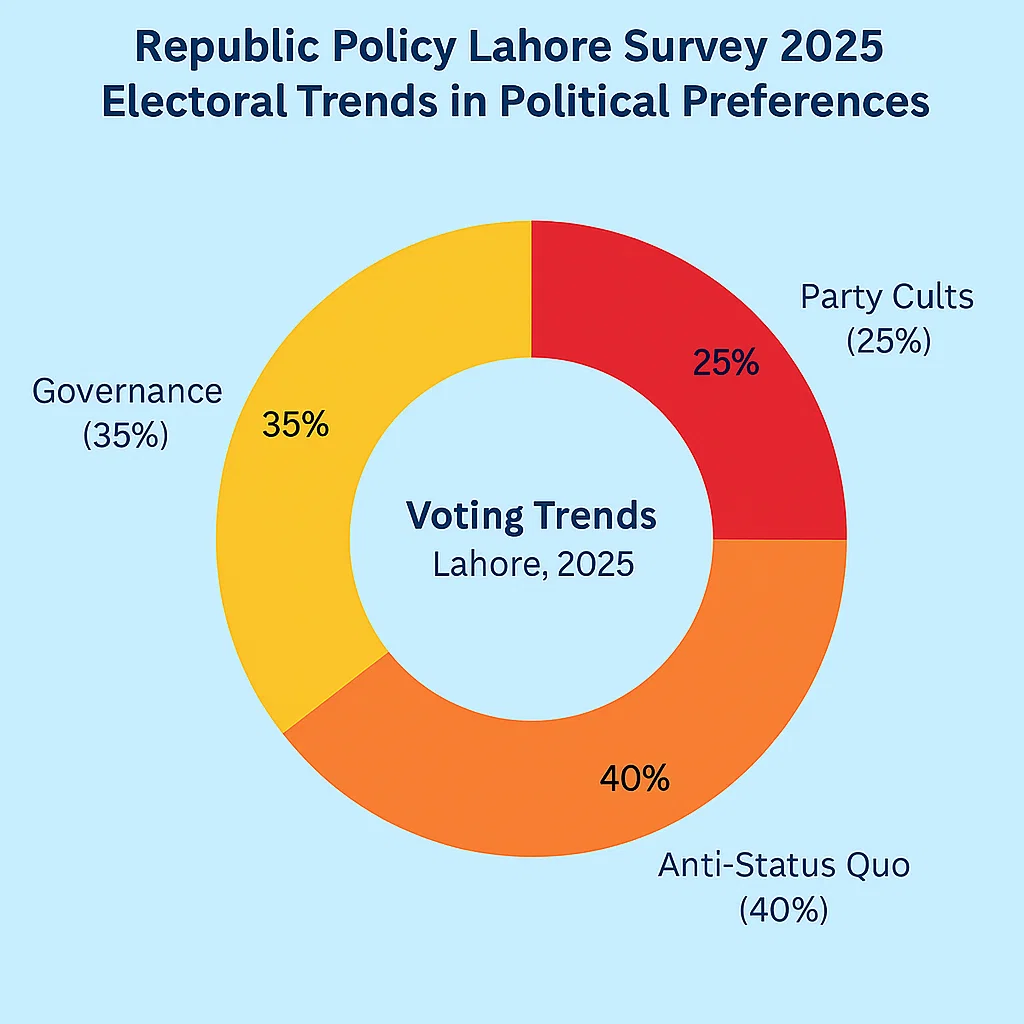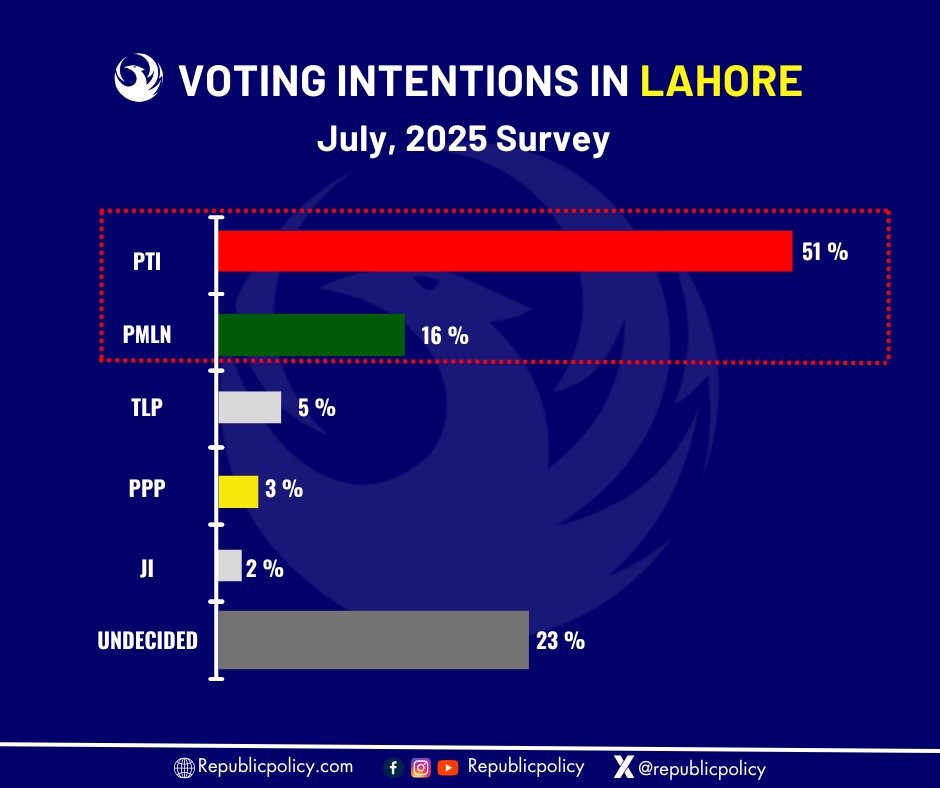Introduction
Administrative reforms have historically been the most neglected but simultaneously the most critical component of governance in Pakistan. While political debates often revolve around elections, legislation, and constitutional amendments, the machinery that translates constitutional commands into public action—the administration—remains outdated, oversized, and underperforming. It is impossible to imagine good governance, effective service delivery, or institutional performance without a reformed administrative system. Pakistan’s experience since independence provides abundant evidence that no matter how progressive the laws, no matter how ambitious the political promises, they collapse into frustration if the administrative structures charged with their implementation are dysfunctional.
The Constitution of Pakistan provides a clear framework for the creation and regulation of institutions. Article 142, read with Schedule IV, 97 and 137 divides the legislative and executive domains between the federation and the provinces. The framers of the Constitution envisaged a federal republic where each level of government is equipped with the institutions necessary to discharge its responsibilities. Article 240 further empowers the state to establish services and posts, and Article 242 provides for service commissions to ensure recruitment is conducted on merit. These provisions are not incidental—they constitute the very backbone of administrative law in Pakistan. They mean that the creation of every department, the management of every cadre, and the recruitment of every officer must align with constitutional mandates. Yet, in practice, Pakistan has deviated from this design. Ministries, authorities, and corporations have been created in excess, often overlapping in jurisdiction, leading to legal disorder and practical inefficiency. This drift from constitutional discipline has left the country with a massive but ineffective state apparatus.
The urgency of administrative reform becomes apparent once we examine the daily experience of citizens. The citizen interacts with the state not through abstract constitutional provisions but through its administrative organs: the hospital that fails to provide timely treatment, the school that lacks teachers, the municipal office that cannot supply clean water, or the district administration that cannot enforce the law. When these organizations are poorly structured, under-skilled, or starved of resources, the citizen perceives the state as absent or unjust. The erosion of trust in public institutions is, therefore, directly linked to administrative failure. No amount of rhetoric about democracy or constitutionalism can compensate for the failure of governance on the ground. This is why reforming administration is not a technical exercise but a political and constitutional necessity.
The size of Pakistan’s government provides the clearest example of the mismatch between administrative form and function. Both the federation and the provinces maintain sprawling ministries and departments, many of which duplicate each other’s work. For instance, the federal government continues to retain roles in health, education, and agriculture, despite the fact that these are primarily provincial subjects after the Eighteenth Amendment. Similarly, provinces often replicate federal structures instead of focusing on their devolved responsibilities. This results in duplication, waste, and confusion over jurisdiction. The Council of Common Interests (CCI), which was created precisely to coordinate shared powers, remains underutilized. Rather than becoming a vibrant platform of federalism, it is treated as a ceremonial forum. Administrative reform must therefore begin by realigning institutions with constitutional competencies. The federation must restrict itself to its enumerated subjects, the provinces must assume responsibility for devolved functions, and the CCI must be strengthened as a binding intergovernmental mechanism.
The legal argument for reform also extends to the manner in which services and posts are created. Article 240 of the Constitution makes it clear that posts and services are to be regulated by law, not by executive whim. Yet, successive governments have created authorities and corporations outside the discipline of law, often through executive orders or notifications. These bodies become convenient havens for retired bureaucrats or political appointees. Their functions frequently overlap with existing ministries, causing jurisdictional confusion and draining resources. This is not only inefficient but unconstitutional. The principle of rule of law demands that every organization of the state must have a legal foundation, a defined mandate, and an accountability mechanism. Reforming the administrative system would mean auditing all existing organizations, abolishing redundant ones, and restructuring those that have a legitimate purpose. In this way, administrative reform becomes a process of restoring legality to state practice.
At the heart of administration, however, lies human resource capacity. The Constitution envisages a service structure based on merit, fairness, and efficiency, implemented through independent service commissions under Article 242. In practice, however, the civil service of Pakistan has become a generalist rather than a specialist body. Officers are rotated across diverse fields without developing expertise, leading to weak policymaking and poor implementation. Training academies remain outdated, focusing more on ceremonial knowledge than on practical skills required for twenty-first century governance. Promotions are based on seniority rather than performance, which discourages innovation and efficiency. The result is a bureaucracy that is large in number but low in productivity. Administrative reform must therefore prioritize the professionalization of human resources. Specialized cadres must be created in fields such as health, education, technology, and finance. Recruitment must be merit-based, training must be modernized, and performance evaluations must be linked to tangible outcomes. Without reforming the human resource base, institutions will remain shells without substance.
The failure to reform has grave consequences for service delivery. Take the health sector as an example. Despite significant budget allocations, public hospitals are overcrowded, under-staffed, and under-equipped. The problem is not merely financial but administrative. Hospital management is centralized, bureaucratic procedures stifle innovation, and there is little accountability for outcomes. Similarly, in education, the duplication of departments and lack of specialized human resources result in weak policy implementation and poor learning outcomes. Municipal services, too, suffer from the absence of empowered local governments. District administrations, controlled by provincial bureaucracies, have neither the autonomy nor the resources to respond effectively to citizen needs. In each of these cases, the problem is administrative, and the solution lies in reform. Rationalizing organizational structures, empowering local governments, and introducing performance-based accountability can directly improve service delivery.
The principle of federalism further strengthens the case for reform. Pakistan’s Constitution is federal in spirit and design. Article 142(c) and Schedule IV clearly divide subjects between the federation and the provinces. Yet, without administrative reform, this federal spirit remains a dead letter. When federal ministries interfere in devolved subjects, they not only waste resources but also violate the autonomy of provinces. Similarly, when provinces fail to empower local governments, they deprive citizens of responsive governance. Reform, therefore, is essential to preserve the constitutional promise of federalism. It would mean downsizing the federal government to its enumerated subjects, strengthening provincial capacities in devolved areas, and empowering local councils with administrative and financial autonomy. This alignment would not only improve governance but also reduce political tensions between different tiers of government.
It is equally important to consider the implications of administrative inefficiency for democracy itself. A democratic state is not judged merely by the regularity of its elections but by the quality of its governance. If citizens consistently experience the state as corrupt, inefficient, or unjust, their faith in democracy erodes. They may turn to populist leaders, parallel governance networks, or even non-state actors to fulfill their needs. Pakistan has already witnessed the consequences of weak administration in the rise of informal justice systems, patronage-based politics, and militant organizations. In each case, the absence of reliable state institutions created space for alternatives. Administrative reform, therefore, is not only about efficiency; it is about safeguarding democracy by ensuring that citizens experience the state as responsive, just, and legitimate.
One must also address the political economy of resistance to reform. Bureaucrats and politicians, despite their occasional conflicts, share an interest in preserving the current system. Bureaucrats seek higher grades and promotions, which are made possible by creating new posts and organizations. Politicians seek ministerial positions and control over departments, which increase with the expansion of government. Together, they collude to expand rather than rationalize the administrative system. Breaking this compact is perhaps the greatest challenge of reform. It requires political will, constitutional fidelity, and civic pressure. Citizens must demand that their taxes fund efficient service delivery rather than oversized bureaucracies. Civil society and think tanks must continue to highlight the costs of inefficiency. Courts must interpret constitutional provisions to limit arbitrary executive creation of institutions. Only through such combined pressure can the inertia of the administrative elite be overcome.
The way forward must be comprehensive. Reform cannot be piecemeal, focusing on one sector while ignoring others. It must begin with a constitutional audit of all ministries, departments, and authorities to ensure alignment with Articles 142 and 240. Redundant and overlapping bodies must be abolished. Federal ministries must restrict themselves to enumerated subjects, and provincial governments must build capacity in devolved areas. The CCI must be transformed into a permanent, professional forum with binding decision-making powers. Local governments must be empowered with administrative and financial authority to deliver services directly to citizens. The civil service must be restructured into specialized cadres, with recruitment conducted through independent and professional commissions. Training institutions must be modernized, and promotions must be linked to performance rather than seniority. Finally, public organizations must be given financial autonomy and digital systems to reduce corruption and improve efficiency.
In conclusion, administrative reform is not optional for Pakistan; it is indispensable. The Constitution provides the framework, but it has been ignored in practice. The result is a state that is large but ineffective, expensive but unproductive, and present in form but absent in function. Reforming the administrative system would mean realigning institutions with constitutional competencies, professionalizing human resources, and modernizing operations. It would mean restoring legality to the creation of organizations, empowering local governments to deliver services, and strengthening federalism through the CCI. Above all, it would mean transforming the daily experience of citizens, who would encounter the state as efficient, just, and responsive rather than corrupt and absent. Administrative reform, therefore, is the key to good governance, effective service delivery, and institutional performance. Without it, Pakistan’s constitutional promise will remain unfulfilled; with it, the republic can finally begin to deliver on its obligations to the people.
Challenges to Administrative Reforms in Pakistan
Good governance and efficient service delivery are the hallmarks of a functional state. As Republic Policy observes, “the quality of administration is directly proportionate to the objectives of governance”. In Pakistan’s federal parliamentary system, this means aligning institutions and procedures with constitutional mandates, modern management practices, and citizen needs. Pakistan’s inherited colonial-era bureaucracy led governance is widely seen as rigid and resistant to change. Reforming it to achieve the Sustainable Development Goals (SDGs) requires a comprehensive approach covering civil service structure, organizational design, decentralization, digitalization, accountability, and citizen-centric service models. These reforms must reflect international best practices while accommodating Pakistan’s legal, political, and cultural context. Importantly, experts stress that administrative reform is ultimately a political challenge, requiring strong leadership, consensus-building and a willingness to adjust power arrangements.
Civil Service Restructuring: From Generalists to Specialized Cadres
Pakistan’s traditional civil service has been dominated by a single generalist cadre (e.g. the Pakistan Administrative Service, PAS) drawing talent into a unified structure spanning federal, provincial and local levels. This “general cadre” approach has long been criticized for misaligning skills and functions. Indeed, experts note that PAS & other generalist cadre officers often occupy posts in unrelated departments just to advance, undermining organizational autonomy. The consensus view among reformers is that the civil service should shift to multiple specialized cadres. A specialized cadre groups together analogous posts within a functional domain (such as health, education, finance, engineering, or law enforcement). Each cadre would recruit, train and promote its own professionals, ensuring that an administrative secretary of health, for example, has both technical knowledge and bureaucratic skills. This sectoral alignment would improve policy implementation and reduce the risks of corruption arising from excessive discretion.
Specialized cadres also facilitate meritocratic progression. For instance, Pakistan’s neighbors have moved toward differentiated services: Sri Lanka, for example, mandates that senior civil servants complete a Master of Public Management and offers tiered courses for different grades. Pakistan has taken steps in this direction by emphasizing continuous training and even weighting training outcomes (30%) into promotion decisions. More broadly, recruitment should balance broad-based civil service entry with direct lateral hires of specialized professionals (e.g. IT experts, doctors, engineers, economists) for technical roles. Proposals include creating new cadres and allowing open competition from the private sector. For example, RP study urges “a pronounced shift to a contractual basis of appointments for a whole range of skills”, with many roles hired on fixed-term, market-based contracts tied to specific projects or facilities. Over time, traditional generalist posts would be phased out or reclassified into these specialized streams.
Finally, cadre reform requires modern HR practices: transparent recruitment, well-defined promotions, and performance-linked contracts. Transparency International and academic analyses highlight how Pakistan’s civil service suffers from patronage. Yet recent research found that discretionary promotions can reward ability: junior officers with higher measured performance were fast-tracked more often than those with political connections. To institutionalize such meritocracy, Pakistan should implement clear evaluation metrics (KPIs), strengthen inspector-general offices, and empower public service commissions. In particular, reforms must delineate the roles of civil service versus political leadership, enforce competitive exams and lateral entry, and protect competent officials from unfair transfers. In sum, rebuilding the civil service around specialized, career-aligned cadres and merit-based rules is essential for better administration.
Restructuring Ministries and Departments
The structure of government ministries must mirror constitutional divisions of power. Under the 1973 Constitution, the Federal Legislative Lists (Schedule IV) enumerate subject-matter jurisdictions. Part I (59 entries) covers exclusive federal domains (e.g., defense, foreign affairs, finance, communication, commerce, law), while Part II (18 entries) belongs to the Council of Common Interests (CCI). All other matters are provincial or local by default. In practice, however, Pakistan’s federal cabinet has ballooned to 30+ ministries, many of which cover areas now devolved to provinces or meant for CCI coordination. This bloated structure wastes resources and violates constitutional limits.
Analysts recommend rationalizing federal ministries strictly to the six core portfolios that align with Part I of the federal list: Defense, Foreign Affairs, Finance, Communication, Commerce, and Law. For instance, subjects like health, education, agriculture, and housing are now provincial duties and should be handled by provinces, not by separate federal ministries. Similarly, Part II subjects (e.g., railways, energy, census) should remain under the CCI’s purview and its secretariat. The purpose is to prevent federal encroachment: as RP commentary puts it, “it is compulsory to establish federal and CCI ministries according to [the Federal Legislative List]” . Eliminating unconstitutional ministries will reduce federal budget expenditure and force the center to focus on its legitimate functions. In fact, scholars note that Pakistan’s federal spending is dominated by just two items – defense and debt servicing – largely due to oversized bureaucracies and state enterprises. Trimming federal departments to the constitutional minimum would free resources for provinces and local governments, where most citizens live. Furthermore, a strong local government in Islam Abad will end this argument to develop ministries for federal jurisdiction only.
Provincial governments also need to merge and compress departments. Currently, provinces typically maintain 40–50 separate departments (e.g., Agriculture, Livestock, Fisheries, Forestry, Environment, Food; then separate departments for Primary Education, Secondary Education, Higher Education; Health, Population Welfare, etc.). In reality, each province has only six fundamental areas under its exclusive domain (e.g. agriculture, education, health, home, finance/development, local government). Thus provinces should collapse analogous functions. For example, Agriculture, Livestock, Fisheries and related bodies could form one unified Ministry of Agriculture. All education sectors (primary, secondary, special education, literacy) could merge into a single Education Ministry. Health, Population Welfare and associated agencies should unify. Similarly, local government, planning and development could be one department, and Home, Law & Justice another. This consolidation is both legally and economically justified: “there is no need to raise so many departments with so many public employees at the expense of the state exchequer”. Reduced departmental count will cut duplication and simplify oversight. (For instance, Pakistan’s Punjab province once had 22 departments in 2000 but now has 48, an obvious sign of drift.)
Other structural reforms include abolishing redundant roles like the provincial Chief Secretary as an all-powerful administrator. The Constitution vests executive authority in the Chief Minister (CM) as head of government. Yet in practice the bureaucratic Chief Secretary (appointed by the federal Establishment Division) often dominates the CM’s office. Commentators argue this is anachronistic: under parliamentary governance, “the chief secretary post should not exist” in its current form. In some provinces, reformers have merged the Cabinet Secretary and Chief Secretary functions or proposed replacing them with a service ministry headed by a politician. Similar rationalization can apply to the Prime Minister’s and Chief Minister’s secretariats, governors’ houses, and honorariums for ministers. Overall, departments and offices must be realigned to the Constitution’s mandates, shedding any colonial or political over-reach to save money and increase capacity.
Decentralization and Devolution
Pakistan’s constitution creates three levels of government – federal, provincial and local – with exclusive spheres of authority. Article 140-A, for example, makes local government an obligation: provinces must legislate and hold regular elections for local councils. Yet in practice, local bodies remain weak while power is centralized in provincial capitals. Analysts find that local governments “never enjoyed a secure term nor a clear mandate”. Provincial authorities have often undermined LGs (reversing promised budget shares, creating parallel agencies, or appointing loyal administrators). For instance, a PIDE study documents how the pledge to give 70% of development funds to LGs was reversed in Khyber Pakhtunkhwa, Punjab sidelined elected councils by forming dozens of provincial corporations, and Sindh empowered appointed officials to veto local plans. The result is that LGs “have remained more of a façade… never granted the autonomy to plan or execute local policies”. The current system even forces local taxes to be handed over to provinces for redistribution. This design disincentivizes local revenue-generation: if mayors can’t keep their tax collections, why would they tax at all? The irony is that most social services (education, health, sanitation, etc.) should logically be implemented at the district or municipal level. Empowering local governments – with constitutional guarantees, own-source revenue, clear functions, and stable terms – is key to better service delivery.
To move forward, Pakistan should strictly follow Schedule IV’s residuary principle by devolving non-federal subjects to provinces, and provincial subjects to local councils. Ministries of local government (in each province) must be empowered, and provincial civil servants (not PAS officers) should staff district administrations in line with decentralization. Independent local taxation (property tax, business levies, etc.) should flow directly to local budgets, as in effective federations. For example, global experience shows that municipalities often perform well when they can retain revenues and borrow responsibly. In short, governance must respect subsidiarity: decision-making and expenditure responsibilities should sit with the closest accountable level to citizens. As one expert notes, in Pakistan the “episode nature” of LG reforms has created perverse incentives: politicians actively weaken local bodies to protect their own turf. Correcting this requires political will at the center and provinces – enabling MNAs/MPAs to focus on legislation while mayors and nazims handle grassroots development.
E‑Governance, Digital Transformation and Skilled Cadres
Digital technology is a crucial enabler of administrative reform. Pakistan’s leadership has recognized this: Vision 2025 and the Digital Pakistan Policy 2018 identify ICT as a “strategic enabler for an accelerated digitization ecosystem” to build a knowledge economy. On the ground, Pakistan enjoys widespread digital connectivity: over 194 million mobile subscribers and 56% broadband penetration, along with 78% 3G/4G coverage nationwide. These statistics suggest the infrastructure exists for e‑governance to flourish.
The government is piloting citizen‑centric digital services. For example, Khyber Pakhtunkhwa’s “e-Khidmat Markaz” concept combines multiple local services (banking, bills, documents) under one roof, and major cities now offer online portals for utility payments and registrations. Notably, the National Database & Registration Authority (NADRA) has developed the “Rahbar” app – a mobile tool providing real-time wait times and location information for identity centers – explicitly to empower citizens and reduce bureaucratic queues. NADRA has also enabled full mobile self-service and SMS tracking of applications, transforming how ordinary people engage with government. These examples demonstrate how lean digital solutions can radically improve transparency and convenience.
Moving forward, Pakistan should scale up e-governance by developing interoperable digital platforms and streamlined e‑offices. Key steps include implementing a government-wide enterprise architecture (as envisaged in the World Bank’s DEEP initiative), integrating databases across ministries, and launching one-window portals for common services (citizen portals, business permits, etc.). Investment is also needed in digital ID and payments infrastructure: biometric IDs (NADRA) and mobile money systems can enable direct transfers and benefit targeting (e.g. social protection, subsidies) with minimal leakage. Moreover, enhancing ICT skill cadres within civil service is vital. This means nurturing a cadre of IT-savvy administrators and hiring private-sector specialists in cybersecurity, data science, and digital project management. Training institutions should update curricula in data governance and agile project methods. By modernizing processes and boosting technical capacity, e‑governance can make government more efficient, responsive, and meritocratic.
Accountability and Anti-Corruption Mechanisms
Strengthening accountability is a perennial challenge in Pakistan. Despite numerous initiatives, corruption remains entrenched. The World Bank’s Voice and Accountability Index shows Pakistan well below regional average, and Transparency International ranks the country 140th out of 180. Existing accountability bodies have often failed to restore public confidence. For example, the National Accountability Bureau (NAB) – Pakistan’s main anti-graft agency – has been criticized for selective enforcement, political bias and overreach. Such issues underline the need for reforming Pakistan’s accountability framework on multiple fronts.
First, Pakistan should delineate administrative vs criminal accountability. Routine procedural lapses by officials should be addressed through administrative law – internal audits, vigilance inquiry or departmental tribunals – rather than by automatically invoking criminal statutes. Excessive criminalization of bureaucratic discretion has a chilling effect on decision‑making. Many experts call for clarifying “administrative immunity” thresholds: honest mistakes or policy disagreements should not trigger corruption charges. Conversely, cases of bribery, fraud or abuse of office must be prosecuted fairly and transparently.
Second, internal oversight must be bolstered. Ministries and agencies need stronger internal audit and inspection units, empowered to review spending and hiring with independence. As [63†L417-L419] suggests, “independent oversight bodies” can monitor appointments and compliance with federalism principles, and similarly such bodies (e.g. Civil Services Commission, Anti-Corruption Commission) should audit executive conduct to prevent political interference. Whistleblower protections should be instituted to safeguard honest officials and citizens who expose corruption.
Third, Pakistan can learn from global best practices. Many countries adopt measures like e-procurement portals, open budgets, and citizen service charters to make corruption harder. NADRA’s own reforms, for instance, introduced public dashboards of procurement and tight digital tracking of personnel. Emulating such transparency and introducing punishment incentives (e.g. performance bonuses for clean audits) could be effective. Finally, oversight of anti-corruption agencies themselves must be strengthened – for instance, by setting fixed tenure limits for officials, inter‑agency coordination councils, and judicial review of major cases. Only by combining legal reform, better internal controls, and depoliticized enforcement can Pakistan move toward accountability in practice.
Capacity Building and Training of Civil Servants
Investing in human capital is at the heart of any administrative reform. Pakistan already has many training institutes (over 150 entities at the federal level, but these have not fully bridged capacity gaps. Reports note that, paradoxically, despite 152 training centers “the prevalent concern of capacity shortage in the public sector raises questions about their effectiveness”. This calls for a strategic overhaul of training programs and career development.
Training should be demand-driven, practical and continuous. PIDE experts highlight that past training was often generic box-checking; courses must now be specialized and scenario-based. For example, a mid-career civil servant might undertake short courses in digital governance or public finance at relevant academies, tied closely to their ministry’s needs. The civil service can adopt models like Sri Lanka’s, which assigns training categories by rank and links outcomes to promotion. In fact, Pakistan’s promotion policy now gives 30% weight to training performance, signaling recognition that “training outcomes” should count. Going further, an annual mandatory refresher on ethics, citizen interaction, and sector-specific skills could be instituted.
Capacity building also means cultivating specialized public administration expertise. Academia and think tanks should be involved: top universities can collaborate with civil service academies to offer modules on governance, data analysis, and policy evaluation. Civil servants should have access to fellowships and international seminars to learn best practices abroad. Moreover, institutions should measure training impact. As one seasoned bureaucrat notes, civil servants today solve practical problems through simulations and field projects during their mid-career courses; such hands-on training links classroom learning to real work. By aligning training with career paths and upgrading skill levels (particularly in IT, financial management, and project appraisal), Pakistan can create a more professional, capable bureaucracy.
Performance Evaluation and Meritocracy
Effective administration requires that employees are evaluated fairly and rewarded for results. Pakistan currently uses Annual Confidential Reports (ACRs) as the main appraisal tool, but these are criticized for lack of transparency and potential biases. Reformers propose introducing systematic performance contracts and KPIs. For instance, officers could sign performance agreements at the start of a term (e.g. target number of schools built, budget spending rates, service improvement indices). Mid-year and final reviews would assess whether goals were met, with outcomes affecting pay increments and promotions.
Merit must guide hiring and advancement. In practice, civil service recruitment is competitive, but promotions and postings can be influenced by patronage. Yet recent research indicates that when transparent measures are in place, discretion can favor competence. One study found that bureaucrats with higher objective performance (measured by tax collection) were significantly more likely to be fast-tracked than equally connected peers. This suggests that if information on performance is captured and used, advancement can reward ability rather than connections. Pakistan should thus improve data-tracking of officer performance and remove opaque criteria. Promotions up to a certain grade might even involve open exam+interview panels. The creation of a Seniority-plus-Merit system, in which seniority provides base eligibility but is overlaid with demonstrable achievements, would encourage public servants to excel.
Alongside, punitive measures should be fair and swift. Underperforming or corrupt officials should face administrative penalties (e.g. denial of increments, demotion, dismissal) after due process. However, petty infractions should not become a trigger for criminal cases; as noted above, the line between administrative and criminal accountability must be clear. Over time, embedding a culture of merit and constructive feedback – rather than entitlement – will align incentives with performance.
Regulatory and Legal Framework Reforms
A robust legal framework underpins all administrative structures. Pakistan’s laws governing public service, procurement, and regulation need updating to reflect reform goals. Key reforms include:
- Civil Service Acts and Rules: The Civil Servants Act 1973 along with provincial civil servants acts and related Efficiency & Discipline Rules should be reviewed. They must codify career management (transfer rules, promotion quotas), clarify impartiality standards, and remove colonial vestiges. For example, restrictions on post-retirement lobbying, or rules preventing patronage postings, should be enforced. Many experts recommend shifting from defined-benefit pensions to defined-contribution schemes for new entrants, to encourage mobility and reduce long-term liabilities (something Pakistan’s policymakers have also considered).
- Local Government Acts: Since each province passed its own local government law (after 18th Amendment), inconsistencies remain. Provinces should harmonize LG legislation so that core principles (five-year terms, free elections, clear functions, revenue sources) are consistent. As the Republic Policy review notes, provincially appointed administrators must give way to elected mayors who have legal authority over the same local subjects. Accordingly, the office of deputy commissioner may be abolished or reformed as per local government needs and requirements, as happened in the Musharaf era.
- Service Codes: Rules of Business for federal and provincial governments should be updated. For example, powers currently vested in Chiefs of Civil Services (federal Cabinet Secretary or provincial Chief Secretary) could be reallocated to the Prime Minister or Chief Minister, in line with parliamentary norms and legislative law. Many departments still operate under decades-old departmental rules; modernization (including e-office procedures) is long overdue.
- Procurement and Financial Laws: Strengthening the Public Procurement Regulatory Authority (PPRA) rules and ensuring all tender processes are e-published can reduce corruption. Financial rules (e.g. Delegation of Financial Powers) should empower lower-level managers to act quickly without frequent higher-level permissions.
Reforming the legal framework must go hand-in-hand with enforcement. Weak rules are as bad as no rules. Pakistan should empower bodies like the Auditor General, Public Accounts Committees and independent commissions to hold governments to account under the new laws.
Financial and Budgetary Reforms
Administrative reform and public finance are closely linked. A lean structure improves fiscal discipline, and better budget processes enhance governance. In this context, Pakistan must realign budgetary powers to follow constitutional lines. Currently, the federal budget is bloated: millions are spent on obsolete ministries and loss-making public enterprises. As one analysis notes, “the federal government has two significant expenses: defence and debt servicing,” largely because of the costs of overstaffed federal bodies. By contrast, provinces and local governments – closer to the people – end up underfunded for service delivery.
To correct this, fiscal reforms should include:
- Right-Sizing Ministries: As discussed, pruning federal and provincial headcounts will reduce salary bills and overhead. The Finance Ministry can then redirect savings into development projects or transfers to provinces. For example, analysts suggest repurposing the budgets of abolished federal ministries to subnational governments, the “locus of the ordinary citizens”.
- Transparent Budget Process: Pakistan should strengthen the budgetary autonomy of provinces via fully empowered National Finance Commissions (NFC) that allocate revenue shares. The NFC can be made more independent (e.g. using technocrats in the commission) to resist political manipulation. Similarly, provinces should set up Provincial Finance Commissions (PFCs) to determine local government funding, rather than ad-hoc allocations.
- Participatory Budgeting: At the district level, local stakeholders (citizens, businesses) can be involved through public consultations on budgets. This is a hallmark of modern governance and helps align spending with local priorities. E-governance tools (e.g. publishing budget documents online, holding public hearings) can facilitate this.
- User Fees and Cost Recovery: Not all public services must be free. Introducing reasonable user fees for utilities or regulatory services (with exemptions for the poor) can finance improvements. Crucially, any such fees collected at the local level should stay local, as noted above.
Ultimately, financial reform must enforce the principle that fiscal power flows with legislative authority. Federal spending should focus on national concerns (defense, federal debt, major infrastructure), while development and social spending should be driven by provinces and local governments where competence resides.
Public–Private Partnerships (PPPs)
Given resource constraints, Pakistan increasingly looks to Public–Private Partnerships (PPPs) to finance and operate infrastructure and social services. PPPs can bring technical expertise and capital into projects (roads, energy, hospitals, schools) that governments alone struggle to deliver. However, PPPs require careful governance. Key elements of a robust PPP framework include transparent project selection, competitive bidding, and fair risk-sharing contracts. Pakistan’s PPP Authority (P3A) has put in place guidelines, and a 2017 PPP Act exists, but oversight must be strengthened. For instance, independent feasibility assessments and parliamentary committees can review large PPP deals. Unchecked, PPPs can become a liability (e.g. public guarantees taken on projects with low returns). Learning from international experience, Pakistan should ensure that private partners bear appropriate commercial risk, while the government guarantees reasonable returns. In regulated sectors, independent regulators must monitor quality and pricing. Properly managed PPPs – such as long-term concessions in utilities and transport – can help advance public–private collaboration, one of the components of administrative reform.
Citizen-Centric Service Delivery Models
Ultimately, administrative reform must improve the interface between government and citizens. Pakistan should adopt citizen-centric approaches in policy design and service delivery. This means involving citizens in planning (e.g. social audits, participatory budgeting) and making services accessible.
Digital tools are part of the solution. We have seen how NADRA’s “Rahbar” app and e-services give citizens real-time information. Similar approaches can be applied across the board. For example, online service portals (with mobile access) can allow citizens to apply for permits, pay taxes or lodge complaints from home. Governments at all levels should establish one-stop service centers for in-person support, and robust grievance redress mechanisms. Customer charters specifying service delivery standards (and compensation for lapses) can help set expectations. Policymaking should also incorporate feedback loops: surveys, public consultations and oversight committees ensure policies are responsive.
Internationally, many federations offer models to emulate. For instance, India’s e-Sevottam framework sets service benchmarks, while e-procurement and e-tendering portals increase transparency. Pakistan can similarly adopt “Digital Pakistan” ID-based single sign-on for multiple government services, facilitating cross-sector integration (e.g. linking identity, social welfare, taxation databases to reduce paperwork). Training civil servants in service-design thinking – as NADRA did by creating a Public Engagement department and co-designing services with citizens – will help align bureaucracy with citizen needs.
Comprehensive Administrative Reform Roadmap for Pakistan
Pakistan’s governance system has long suffered from deep structural flaws and inefficiencies that now demand urgent attention. The current administrative machinery is widely acknowledged to be “plagued by inefficiencies, ineffectiveness, a lack of accountability, and widespread corruption”. Such shortcomings have seriously undermined development and obstructed responses to citizens’ pressing needs. In recent years, catastrophic climate events like the 2022 and 2025 floods have laid bare these institutional weaknesses. For example, observers note that neglect of Pakistan’s decentralized governance structure has led to poor coordination between federal and provincial governments during crises. The devastating floods revealed that pre-emptive disaster management was weak and uncoordinated, leaving communities vulnerable and aid efforts hampered by bureaucratic gaps. In short, failures in areas like disaster response, infrastructure, and basic services reflect “inherent system failures and the inadequacy to swiftly respond” to emergencies.
At the same time, Pakistan faces chronic development deficits – in health, education, roads, and the environment – and growing citizen dissatisfaction with red tape, delays, and unaccountable officials. Public surveys and protests increasingly demand more effective, transparent governance. The convergence of climate crisis shocks, economic challenges, and civic discontent makes it clear that reform is no longer optional but an urgent necessity. Many analysts agree that meaningful change must start with aligning institutions to the Constitution’s mandates. Indeed, experts argue that unless ministries and agencies are reshaped to match the powers and responsibilities laid out in Schedule IV of the 1973 Constitution, governance will remain fragmented and inefficient. In practical terms, this means federal bodies can only legitimately handle subjects on the Federal Legislative List (Part I of Schedule IV) and must cede everything else to the provinces or local governments. Without such constitutional alignment, federal agencies risk chronic overreach or duplication, undermining both efficiency and the balance of federation.
Above all, reform must go beyond a few cosmetic fixes. It must reorient the entire administrative culture toward professionalism, merit, and results. This entails not only updating laws and procedures, but also revamping human-resource practices, support structures, and performance management to global best practices. Historical attempts at civil service reform (dating back to the 1950s) have repeatedly stalled on account of political resistance and inertia. Learning from these lessons, a credible reform effort today would proceed in phases – federal, provincial, and local – with clear legal mandates at each level, and strong cross-cutting initiatives on training, accountability, and technology. As one recent policy analysis warns, without decisive reforms to align institutions with constitutional intent, the vision “of a responsive, accountable, and citizen-oriented state” will remain unattainable. The urgency of now is underscored by growing climate pressures and citizen demand, making comprehensive administrative reform a survival imperative for Pakistan.
Phase 1: Federal Level Reform
At the federal tier, the priority is to strictly limit federal ministries and agencies to the subjects listed in Part I of the Federal Legislative List (Schedule IV). Constitutionally, there are only 59 exclusive federal subjects (including defense, foreign affairs, currency, etc.). In practice, however, Pakistan’s central government now fields dozens of ministries with overlapping mandates – many in areas that the Constitution assigns either to the provinces or to joint federal-provincial jurisdiction. Reform must therefore begin with a downsizing and realignment: the federal cabinet should be trimmed to roughly 10 core ministries corresponding exactly to its constitutional domain. For example, truly national subjects like Defense, Foreign Affairs, Finance, and Commerce would remain federally run, whereas areas such as primary education, agriculture, or local infrastructure would be devolved. Bringing federal functions into constitutional conformity requires legislative action: each remaining ministry should be founded on a clear legal statute defining its role, while any ministries on devolved subjects must be abolished or merged. As one policy expert notes, new ministries or departments created by mere notification (without parliamentary law) are constitutionally fragile and open to challenge. Thus, reformers should pass new Acts to authorize the lean federal ministries, simultaneously dismantling or repurposing obsolete ones (with transition plans for affected staff and assets).
This realignment will end the costly duplication of effort. Under the new structure, a Federal Ministry of Communications/Transport would handle national highways, aviation, and railways (where appropriate), whereas a Provincial or local agency would handle district roads and rural transit. Judicial and legal reform components – for example, a Federal Law Ministry – would limit itself to constitutional affairs and inter-provincial matters. The overall aim is to eliminate “duplication and fragmentation of functions” by confining federal bodies to their proper sphere. Political champions of reform will need to emphasize that this is not about weakening government but about empowering provinces and locals to do their jobs better. By consolidating centers of decision-making where it belongs, the federal government can focus on core competencies and strategic policy, rather than micromanaging health clinics in Peshawar or road repair in Quetta. Analysts observe that successful constitutional reform requires harmonizing laws and administrative structures at all levels to ensure “compliance with constitutional principles, legislative mandates, and legal guidelines,” fostering a unified approach to governance.
A critical element of Phase 1 is strengthening the Council of Common Interests (CCI) as required under Articles 153–154 of the Constitution. The CCI is meant to be the forum for resolving disputes and coordinating policies on matters of shared or inter-provincial interest (Federal List Part II subjects such as railways, minerals, power, etc.). In practice, the CCI has often been moribund or ad-hoc. Reform would involve creating a full-fledged CCI Secretariat, staffed with legal experts, economists, budget analysts, and technical specialists. Each Part II subject (for example, inter-provincial water sharing, oil and gas exploration, or national transportation networks) would have a dedicated coordination cell under the Secretariat. Relevant federal agencies and provincial departments would be required to report their plans and budgets to the CCI forum, ensuring collective oversight and dispute resolution. As one commentator puts it, the CCI should serve as a neutral platform for “reviewing and standardizing” frameworks that cut across provinces. In short, a robust CCI mechanism will prevent the center from unilaterally running subjects that constitutionally belong to joint or provincial hands and will institutionalize collaboration among the provinces themselves.
Concurrently, the federal government must undertake a legal and legislative clean-up of its ministries. Every remaining federal ministry should be backed by an Act of Parliament, clearly defining its functions. Existing Rules of Business should be rewritten to list only federal subjects (explicitly striking out any devolved areas). Ministries slated for abolition or merger will need legislative decrees or sunset clauses outlining how their staff and resources will be absorbed by other entities. This process eliminates the constitutional uncertainty that has built up over decades of “extra-constitutional agencies and delegated departments” created by executive fiat. Scholars argue that many of Pakistan’s civil service laws and conduct rules date from the colonial era and are now outdated or inconsistent with the 1973 Constitution. A reform approach is to codify or overhaul these laws so that everything from procurement rules to audit procedures aligns with modern standards of transparency and accountability.
Human-resource structures at the federal level must also be reformed to match the leaner ministries. Today, many Pakistani ministries maintain large support-staff hierarchies (drivers, clerks, peons, cooks) and siloed HR cadres. A modern civil service would rationalize support roles, recognizing that officers themselves should possess basic digital and clerical skills. For example, a department secretary in the United States or Singapore might handle email correspondence and simple data entry without assigning those tasks to junior staff. Likewise, reform planners suggest significantly cutting redundant support positions and instead setting minimum administrative skill requirements for officer cadres. This not only saves cost but also empowers civil servants to take ownership of their work. At the same time, each ministry should create a professional HR and cadre unit that uses data to map skills, training needs, and vacancies. This unit would oversee more transparent recruitment and promotion processes, consider lateral entry of specialists (e.g. technocrats for cybersecurity or climate policy), and manage performance appraisals. In short, the federal civil service must shift from a patronage-driven bureaucracy to a performance-oriented professional corps.
Another cross-cutting measure at the federal level is codification and simplification of administrative law. For too long, federal rules on civil service conduct, procurement, and regulatory oversight have been scattered, vague, or overtly colonial. Reformers should compile and update these rules into coherent codes of conduct and service laws that are publicly accessible. For instance, promotion criteria, accountability procedures, and disciplinary rules should be enshrined in law with clear timelines and remedies. As Republic Policy analysts note, many current regulations are ambiguous and occasionally “illegal or unconstitutional” because they clash with post-18th Amendment realities[6]. This codification effort would also target excessive red tape: for example, ministries should streamline permit processes, replace paper filings with digital forms, and abolish obsolete approvals. Simplification not only speeds up service delivery for citizens but also reduces the discretion (and potential corruption) of officials.
Finally, Phase 1 introduces a culture of performance and accountability at the federal core. Leading officials (like federal secretaries and directors) would be placed on fixed-term performance contracts with agreed Key Performance Indicators (KPIs) tied to the ministry’s constitutional mandate. For example, the Health Secretary’s KPIs might include metrics on hospital access or vaccination coverage, rather than paperwork processed. Promotion and posting decisions would increasingly depend on demonstrated results rather than just seniority. The system should allow flexible hiring models: certain top positions (e.g. chief information officer, climate change advisor) could be contractual or open to industry experts. Critical here is strengthening the independence of accountability bodies. Parliament’s Public Accounts Committee, the Auditor General’s office, and anti-corruption agencies must be empowered to review whether ministries are operating within their lawful domain and budget, and meeting performance goals. External oversight would send a message that even top bureaucrats are answerable for waste or failure. In sum, these changes aim to transform the federal government from a sprawling, opaque machine into a smaller, agile, result-driven organization strictly focused on national priorities.
Phase 2: Provincial Level Reform
Parallel to federal restructuring, each province must reorganize itself to match its constitutional responsibilities. Provincial governments currently administer dozens of separate departments – often overlapping and siloed. The first task is to consolidate departments into thematic clusters around the 40-plus provincial subject areas. For example, provinces might fold Agriculture, Livestock, Fisheries, and Forestry into one “Agriculture and Rural Development” ministry. Health and Population Welfare departments could merge with Primary, Secondary, and Higher Education under a single “Human Development” umbrella. Law and Order, Police, and Justice could be realigned into a “Home and Legal Affairs” cluster. Other possible clusters include Finance & Planning, Local Government & Community Development, Environment & Climate Adaptation, and Infrastructure & Works. These clusters should be defined by policy coherence rather than by historic bureaucracy. Merging departments requires detailed planning: leadership posts need redefinition, boards and authorities integrated, and budgets unified. But the payoff is significant – fewer silos means fewer turf wars and faster decision-making. As one analysis suggests, eliminating functional duplication makes the provincial administration “more efficient and streamlined”.
Within the provinces, a major reform is to professionalize the provincial civil services through specialized cadres. Presently, many provinces follow a generalist model where officers are moved randomly from one field to another (law to finance, health to roads) without domain experience. Instead, provinces should create or strengthen technical services for key sectors: a Health Service Group with doctors and health managers; an Education Service Group for teachers and education planners; an Engineering Service for infrastructure projects; and so on. This specialization mirrors practices in modern bureaucracy worldwide and ensures that decision-makers have relevant expertise. It also builds career ladders tied to skill development (e.g. doctors rising to become Provincial Health Secretary). Alongside specialization, promotion and posting decisions must become merit-based and transparent. Arbitrary transfers should be curtailed by fixed tenures or transfer guidelines, subject to oversight. Officers should undergo continuous training linked to their performance outcomes, not just formal qualifications. In essence, the goal is to create provincial services that are experts in their fields rather than generalists guessing in the dark. The PIDE reform roadmap similarly emphasizes the importance of creating “specialized service groups in law, economics, energy, engineering, and planning” to professionalize government at all levels.
Administratively, each province must revise its Rules of Business and legislative processes to reflect these new structures. The powers of the Chief Minister (as head of the provincial executive) should be clearly separated from those of the chief secretary and individual secretaries, to avoid ambiguity. The revised rules should enumerate exactly which department does what, matching the new clustered ministries. Importantly, any creation of new departments, statutory bodies, or services should only occur through the Provincial Assembly by law. This protects against the rampant practice of whimsical new schemes or posts being added by executive order. Provinces should also harmonize their civil service laws, conduct rules, and service regulations to eliminate contradictions. For example, if Punjab and Sindh had different leave policies for bureaucrats, standardizing them by law reduces confusion and perception of unfairness. The legal aim is to create clarity and accountability: all provincial officers know their duties are backed by legislation and cannot be arbitrarily changed.
Fiscal decentralization within provinces is another key reform area. The provincial governments should empower local governments financially consistent with Article 140-A of the Constitution, which mandates devolution. This means provinces must reallocate significant spending powers and revenue sources to districts, tehsils, and municipalities. Provincial Finance Commissions (PFCs) – already required by law – should be activated and given updated formulas to share funds fairly with local tiers. For example, portions of provincial tax revenue (like excise or sales taxes) could be pooled and distributed to districts based on need. Local bodies themselves should be granted the right to levy certain taxes (such as property tax, local service fees, or business licenses) and to keep those revenues. In practice, provinces like Punjab and Sindh have historically underutilized local revenue options, weakening grassroots governance. Experts insist that “local governments should be given their due share of revenue instruments, such as property tax, user fees and local business taxes,” with capacity-building for local officials. By securing stable funds, local councils can plan realistically for schools, roads, and sanitation. The creation of predictable transfer mechanisms and constitutional protections will deter ad-hoc shifting of budgets at the whim of provincial bureaucrats.
Modernizing the support and administrative culture at the provincial level follows similar principles as the federal reforms. Provinces too should drastically rationalize support staff: evaluate every driver, clerk, or peon position and determine if it is truly needed. Increasingly, provincial officers should handle routine tasks (emails, data entry, basic accounting) themselves, supported by technology, rather than relying on large retinues of junior helpers. At the same time, provincial governments must codify and tighten their civil service HR policies. This includes clear rules on promotions, transfers, and performance management. Training programs should become systematic rather than perfunctory. Introducing digital workflows for approvals, inter-department file circulation, and citizen feedback can dramatically speed up governance. For instance, a centralized e-office system can ensure that no document gets “stuck” in clerical limbo for months. Provinces might also establish empowered autonomy cells or reform wings within the bureaucracy to pilot innovations (like weeding out ghost employees via biometrics or launching citizen service portals). Collectively, these measures will reduce waste and build a more agile provincial administration.
Phase 3: Local Government / Grassroots Level Reform
The final tier of reform is local government, which ultimately brings the state closest to citizens. Each province must fully honor its constitutional obligation to establish and empower local governments with clear functions, elections, and budgets. Article 140-A of the Constitution guarantees that provinces will devolve political, administrative, and fiscal responsibilities to local bodies. In line with this, every district, tehsil, and municipality should be run by an elected council with a fixed five-year term, transparent rules for decision-making, and a budget they help determine. Laws must insulate local bodies from arbitrary dissolution or takeover by provincial authorities. Only with guaranteed tenure and authority can local councils plan long-term development. International experience shows that well-structured local governments improve service delivery and accountability. As one policy analysis notes, local bodies “form the interface between the state and citizens,” handling community concerns such as waste management, water supply, and local roads. Empowering them realizes the 18th Amendment’s promise of genuine grassroots democracy.
In practice, this means reassigning as many devolved functions to local governments as appropriate. Services that are clearly local in nature – for example, street lighting, solid waste collection, local road maintenance, sanitation, community parks, and basic health and educational outreach – should be managed by municipal or district administrations. For instance, local governments can be tasked with issuing water connections, planning market fees, licensing taxis, and running urban clinics. The provinces would retain policy guidance and funding responsibilities in major areas like health and education, but local units would handle implementation in their jurisdictions. When citizens have easily accessible local officials, state accountability becomes tangible. Moreover, local governments should handle permit processes for small businesses and building approvals. Rather than going through a distant civil service, a shopkeeper or farmer can deal with a locally elected council, reducing corruption and delay.
To enable these functions, local governments must be given adequate resources. This involves stable financial devolution and revenue-raising powers. Ideally, local bodies would keep a portion of locally generated revenue. For example, city governments could administer property tax, motor vehicle registration fees, and commercial license fees directly, with only a small share sent upward. Rural councils might collect small taxes on electricity connections or veterinary services. The failure to do so has been widely documented: in many provinces, property tax administration remains in the hands of provincial departments, leaving municipalities starved for funds. Reform dictates that local authorities have fiscal autonomy. Their budgets should come from a combination of provincial transfers (via PFC awards) and their own levies. Provincial legislatures must commit to predictable funding formulas so that local budgets aren’t cut arbitrarily. Analysts emphasize that decentralization is only meaningful if “budget-making, development planning, and service delivery are decentralized in practice, not just in principle”.
At the local level, human resources need transformation as well. Instead of deploying only deputies of provincial civil servants, local governments should build their own cadres of technical and administrative staff. For example, a municipal engineering wing (with civil engineers and architects), a sanitation department (with environmental experts), and a small urban planning team are appropriate. These officials would report to locally elected councils rather than distant provincial secretaries. This ensures that local priorities – a clinic or school in a village, a drainage project in a town – are planned by those who know the community. Support staff rationalization also applies here: no need for a dozen clerks when digital record-keeping can be used. Local officials should be trained to use tablets or apps for on-the-spot data entry (like GIS mapping of assets). The idea is to flatten the bureaucracy so citizens deal with real decision-makers instead of faceless intermediaries.
Finally, the ethos of service must be instilled at the grassroots. Citizens should see local government offices as one-stop centers where they can apply for services (birth certificates, building permits, welfare payments) and lodge complaints. There should be online or even mobile apps where citizens can track the status of their applications, submit feedback, or report local issues (potholes, illegal dumping, power outages). Transparency is key: local councils must hold regular public meetings where budgets and development plans are tabled, and citizens can speak. Publicizing performance metrics (e.g. percent of garbage collected on schedule, or hospital beds operational) will create pressure for results. Through these measures – constitutional guarantees, clear local functions, dedicated staff, and citizen-oriented service tools – local government can fulfill its role as the face of the state. Lastly, offices of deputy commissioners may be reformed or abolished as per local government needs. Federal and provincial interventions may continue to happen through their respective departments working in the districts and provincial capitals. Political, administrative and financial independence of local government is critical administrative reform.
CCI Reforms
Articles 153 and 154 read with federal legislative list part II, require establishment of a functional CCI between federation and provincial subjects. There are 18 subjects and CCI must take control and power of these.
Making CCI functional is critical for federalism, good governance, and service delivery. How can a government like CCI, which is common between federation and provinces, remain dysfunctional? The subjects, railway, electricity, mines and especially regulating professions are the subject matters of the CCI.
Cross-Cutting Reforms (Apply to All Levels)
Beyond the three-tier restructuring, a number of reforms cut across federal, provincial, and local administration. One major theme is rationalizing support-class hierarchies. Throughout Pakistan’s government, countless positions (drivers, peons, clerks, guards, cooks) exist partly due to tradition rather than necessity. Reforms should evaluate these roles: where possible, the burden should be shifted onto officers themselves or automated systems. For example, instead of maintaining a driver pool, officials could share vehicles or use ride-sharing services. Instead of file runners, the system should use digital document tracking. This requires investing in basic computer and digital literacy training for officers at all levels. The aim is to have a lean staff that does real work, not layers of help. Analysts note that modern administrations reduce such hierarchies by embedding core administrative skills in their professional cadres.
Another overarching reform is modern human resource management. Civil service hiring should not be rigidly tied to entrance exams alone; it should allow for contractual appointments and lateral entry of subject-matter experts. For instance, both federal and provincial public service commissions could allocate a certain number of slots each year for direct recruitment of engineers, doctors, ICT specialists, or climate scientists who meet professional criteria, bypassing lengthy generalist exams. Term contracts (say, 3–5 years) can be offered for specialized managers and project leaders. Performance management must be standardized: every officer should have a job description with goals, regular appraisals, and balanced scorecards. Good performance should bring incentives (faster promotion, bonuses, or training opportunities), while chronic poor performance or misconduct should carry real consequences (reassignment, demotion, or dismissal) – all done transparently. Rules on postings and transfers should be codified to prevent political interference and nepotism; for example, fixed tour-of-duty durations (e.g. 2–3 years per post) can limit arbitrary shuffling.
Underpinning these changes is codification and simplification of laws and rules. All levels of government should identify obsolete or overlapping regulations and repeal them. The target is a legal framework where citizens and officials alike can easily know who has authority for what. For instance, if both a federal and provincial law potentially cover an issue, the ambiguity must be cleared. Reformers should use the moment to scrub colonial-era statutes (like the old Indian Penal or Civil Procedure Codes still used in admin matters) and replace them with clear, updated acts that fit Pakistan’s current federal structure. Civil service conduct codes, procurement laws, and decentralization statutes all need review. Simplification also means streamlining procedures: governments should minimize the number of approvals needed for licenses or projects and standardize application formats. The end goal is “a clear and consistent legal framework” so that bureaucracy is bound by law rather than by arbitrary practice.
Digital transformation is a key enabler across all tiers. Governments should invest in modern e-governance tools: secure online tax payment portals, digital land registries, electronic procurement systems, e-filing of cases, and mobile apps for citizen services. Databases at different levels should interoperate so that, say, a social welfare beneficiary’s data can be verified across departments. Many advanced countries use data analytics to monitor bureaucratic bottlenecks, and Pakistan can adapt such models. For example, dashboards could show delays in processing permits, or track the status of development projects. By leveraging information technology and even rudimentary AI (such as chatbots for answering common queries), the public sector can automate routine tasks and reduce corruption opportunities. In essence, ICT should make the administration “smarter” – faster, transparent, and more responsive.
Crucially, reforms must tackle institutional culture. Change management programs (often supported by donor agencies or universities) should train current civil servants in the values of accountability, citizen-centric service, and ethical conduct. This might include workshops on anti-corruption practices, codes of ethics, and risk audits. Governments could launch recognition programs (awards for model officers or departments), publish annual “report cards” on departmental performance, and foster peer learning networks. Over time, the incentive structure will reward transparency and innovation: for instance, bureaucrats who successfully digitize a process or cut waiting times could be publicly commended.
Lastly, accountability mechanisms must be fortified at all levels. Strengthened legislative oversight – via empowered parliamentary or provincial assembly committees – should regularly review ministry budgets and outcomes. Independent audit institutions must be free to publish findings on misuse of funds without political interference. Ombudsman offices and citizen complaint bureaus (at both federal and provincial tiers) should actively resolve public grievances. Even local governments should have grievance redress systems, from citizen charters at district offices to online complaint tracking. Ultimately, the judiciary and constitutional courts play a role: they should be ready to enforce reforms if constitutional violations occur. In combination, these cross-cutting reforms will knit together the federal-provincial-local system into a cohesive whole, overcoming the fragmentation that plagues Pakistan’s current governance.
Suggested Implementation Timeline & Sequencing
Practical reform requires careful staging. A phased timeline might proceed as follows:
1. Phase 1 (0–12 months) – Year 1: Legal and Structural Foundations. Draft and pass legislation to restrict federal ministries to Part I subjects of the Federal Legislative List. Establish or authorize the CCI Secretariat by law. Rewrite the Federal Rules of Business to reflect these limits. Begin audit of federal ministries and support staff: identify which ministries to merge/abolish and catalog redundant positions. Codify new federal civil service conduct and promotion rules in unified legislation. Set up the HR/cadre units in each ministry. Issue a first set of policy decrees on performance contracts for secretaries and revamp Federal Public Service Commission processes toward digitalization.
2. Phase 2 (12–24 months) – Year 2: Provincial Restructuring. Provincial assemblies pass laws to reorganize departments into the proposed clusters (e.g. merging health-related departments, education departments, etc.). New provincial Rules of Business are enacted and these must not take away the legislative domain of the provincial assemblies. Specialized cadres (health, education, engineering, etc.) are formally recognized by provincial statutes, and existing officers can apply for transfer into them. Provinces activate or reform their Provincial Finance Commissions, allocating clear shares to district/tehsil governments. Local government laws are revised (or new ones passed) to guarantee five-year terms, reserved seats, and devolution of subjects. Major budget transfers to local bodies are executed. Provincial governments initiate training programs for staff on digital administration.
3. Phase 3 (24–36 months) – Year 3: Digitization and Capacity Building. Roll out e-governance platforms across all federal ministries and provincial departments. Launch integrated tax/payment/permit portals where possible. Implement the first round of performance evaluations using KPIs at each level. Start phased elimination of redundant support roles (using attrition and reassignments). Introduce digital case management in courts and information systems in hospitals/schools. Begin awarding lateral-entry positions in identified gaps (e.g. environmental protection specialists). Strengthen accountability forums: empower legislative committees with data, set up new ombudsman branches at provinces, and pilot independent performance audit teams.
4. Phase 4 (36–48 months) – Year 4: Monitoring, Adjustment, and Consolidation. Conduct a comprehensive impact evaluation of the reforms to date. Scale up and replicate successful models (e.g. any province that shows marked improvement in service delivery). Tweak laws or policies where bottlenecks remain (for example, further simplifying regulations). Institutionalize reform bodies so they outlast current political leadership (for example, embedding the CCI Secretariat in law, allocating dedicated budgets). Publicly publish progress reports on governance indicators (speed of permits, social service outcomes, corruption indices, etc.). Continue public outreach to highlight “early wins” (like reduced queues at government offices or easier tax filing) to build citizen support.
5. Phase 5 (48-60 months)—year 5: It is critical to rationalize the public human resources, and it the main challenge to administrative reforms. The public human resources inducted without public service commissions, have serious issues of illegal recruitment. Recruitment, retention and performance of human resources are critical. Unfortunately, the public human resources in the organizations, are not trained, efficient and even honest.
Challenges & Mitigation Strategies
Despite its comprehensiveness, this roadmap will encounter obstacles. Key challenges and mitigations include:
• Political Resistance: Powerful stakeholders – incumbent ministers, senior civil servants, or patronage networks – may oppose losing resources or authority. Mitigation: Build broad coalitions by involving opposition parties and civil society from the start, and frame reforms in terms of citizen benefits. Phased implementation can offer legislators tangible early wins (e.g. a model district that improves services) to offset fears. Use media and public education to generate demand for efficiency. Where possible, codify reforms in law (e.g. through constitutional amendments or regular statutes) to reduce executive rollback.
• Legal and Institutional Inertia: Existing statutes, contracts, and entrenched procedures won’t vanish overnight. Mitigation: Employ sunset clauses (for example, automatically dissolving defunct ministries after a date) and judicial reviews to clear unconstitutional entities. Use the Constitution’s own language (Schedule IV, Article 153) as justification. Establish high-level reform commissions or task forces with cross-party membership to negotiate details. Provide transition support to displaced staff (retraining programs, new jobs) to ease pushback.
• Capacity Constraints: Pakistan currently lacks enough skilled technocrats, IT specialists, and reform-minded administrators to drive these changes. Mitigation: Partner with universities, think tanks, and international agencies for training programs. Encourage diaspora experts to volunteer or consult. Use contractual or short-term hiring (as practiced in the PIDE roadmap’s “National Executive Service” idea to bring in needed expertise. Seed internships or fellowships for young graduates. Prioritize training the trainers – for example, start ‘train-the-trainer’ programs to multiply human-resource development.
• Public Skepticism: Citizens have seen reform promises before go unfulfilled. Mitigation: Ensure transparency at every step. From Year 1, require public reporting of reform progress. Use digital dashboards accessible to all. Launch small, visible projects early: e.g. a redesigned online tax portal or a digitized passport renewal process. When local governments are empowered, publicize their successes (like a town council fixing a persistent pothole problem). Engage citizen groups in monitoring, using tools like community scorecards. The more tangible the improvements, the easier to maintain momentum.
• Continuity Across Governments: Changes of ruling party can endanger long-term reform. Mitigation: Enshrine key reforms in law and regulation, not just executive orders. Encourage a cross-partisan consensus by framing civil service efficiency as a national interest issue (separate from ideology). Involve neutral institutions (e.g. the judiciary) to safeguard the process. Institutionalize reform bodies (like a permanent civil service reform commission with multi-party oversight) and require public updates to cement accountability. Once officials retire to the private sector or academia, they often continue pushing for reforms, providing ongoing intellectual support.
Conclusion: Why This Roadmap Matters
Pakistan’s path to resilient, inclusive development runs through its institutions. Piecemeal fixes will falter if the larger architecture remains out of sync with constitutional realities and modern demands. This roadmap offers an integrated vision: federal ministries trimmed to their rightful scope, provinces run efficiently by specialized cadres, and local governments empowered to serve citizens directly – all underpinned by transparent laws, capable people, and supportive technology. The parts reinforce each other: a lean federal government makes room for empowered provinces, which in turn strengthen their municipalities. No single reform suffices on its own.
International experience shows that nations which align their administrative machinery with law and merit see tangible gains in growth and stability. Conversely, without broad reform Pakistan risks perpetuating waste and public frustration. As one analysis starkly concludes, unless these structural changes are implemented, “the foundational vision of a responsive, accountable, and citizen-oriented state will remain elusive”. By following the timeline above, building coalitions for change, and steadfastly focusing on results, Pakistan can break this cycle of inertia. The dividends would be substantial: streamlined budgets, faster service delivery, better development outcomes, and renewed public trust in governance. In short, these reforms would bring Pakistan closer to fulfilling the promise of its Constitution: a republic governed effectively by the rule of law.
Tariq Mahmood Awan. The writer is a civil servant.


